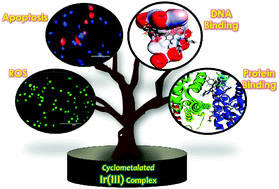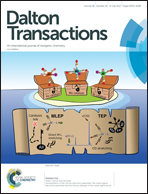Influence of substituents on DNA and protein binding of cyclometalated Ir(iii) complexes and anticancer activity†
Abstract
Synthesis of terpyridyl based ligands 3-([2,2′:6′,2′′-terpyridin]-4′-yl)-7-methoxy-2-(methylthio)-quinolone, (L1); 3-([2,2′:6′,2′′-terpyridin]-4′-yl)-6-methoxyquinolin-2(1H)-one, (L2); 3-([2,2′-:6′,2′′-terpyridin]-4′-yl)-6-methylquinolin-2(1H)-one (L3) and cyclometalated iridium(III) complexes [[Ir(ppy)2L1]+PF6− (1), [Ir(ppy)2L2]+PF6− (2), [Ir(ppy)2L3]+PF6− (3) (2-phenylpyridine = Hppy)] involving these ligands has been described. The ligands L1–L3 and complexes 1–3 have been thoroughly characterized by elemental analyses, spectral studies (IR, 1H, 13C NMR, UV/vis and fluorescence) ESI-MS, and the structure of 3 has been unambiguously authenticated by single crystal X-ray analyses. UV/vis, fluorescence and circular dichroism spectroscopic studies showed rather efficient binding of 1 with CT-DNA (calf thymus DNA) and BSA (bovine serum albumin) relative to 2 and 3. Molecular docking studies unveiled binding of 1–3 with minor groove of CT-DNA via van der Waal's forces and electrostatically with the hydrophobic moiety of HSA (human serum albumin). The ligands and complexes exhibited moderate cytotoxicity towards MDA-MB-231 (breast cancer cell line) and significant influence on HeLa (cervical cancer cell line) cells. Cytotoxicity, morphological changes, and apoptosis have been followed by MTT (3-(4,5-dimethylthiazol-2-yl)-2,5-diphenyltetrazoliumbromide) assay, Hoechst 33342/PI (PI = propidium iodide) staining, cell cycle analysis by FACS (fluorescence activated cell sorting), and ROS (reactive oxygen species) generation by DCFH-DA (dichlorodihydrofluorescein diacetate) dye. Confocal microscopy images revealed that the drug efficiently initiates apoptosis in the cell cytosol. The IC50 values showed superior cytotoxicity of 1–3 against the HeLa cell line relative to cisplatin, and their ability to induce apoptosis is in the order 1 > 2 > 3.



 Please wait while we load your content...
Please wait while we load your content...